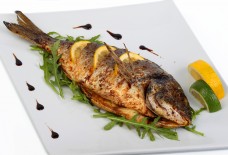The Blue City of Chefchaouen
By: Lindsey Penn/Arab America Contributing Writer
Chefchaouen (meaning “watch the horns”) goes by many names. Locals call it Chaouen, and some call it “The Blue Pearl”. Located close to the coast in northern Morocco, Chefchaouen is famous for the light blue color painted on all of its buildings. It is surrounded by the Rif mountains and is a bit of a trek to get to from any other major Moroccan town. However, the town is worth the long trip-aside from the bright blue, the town mostly operates in Spanish, giving it a very unique feel.
History
Moulay Ali Ben Rachid established Chefchaouen (then called Chaouen) in 1471. He created it as a base to defend the Berbers against any Portuguese invasion and enable the Berbers to attack the Portuguese. At the time, the Portuguese were in Ceuta (Sabta in Arabic), a coastal town in northern Morocco. It is only about 62 miles away from Chefchaouen. Chefchaouen grew when the Ghomara tribes, the Moriscos (the Muslims in Spain), and the Jews living in Spain settled in the town. The Moriscos and the Jews fled from Spain in the 1490s to escape the Spanish government’s new law: convert to Christianity or face execution.
Their migration to Chefchaouen brought the Spanish language and many of the buildings still standing in the town today. They built whitewashed homes with balconies and small patios. Usually, in the middle of the patios, they would plant a citrus tree. The roofs of the houses were also tiled. This style gives the town a slightly more Mediterranean European feel.
Chefchaouen was isolated for the next four or five centuries. Christians were not allowed to enter the town and would be executed if they did. However, in 1920, the Spanish came and took control over the town. When the Spanish arrived, they found all of the residents still speaking Spanish. The Spanish remained in Chefchaouen (with the exception of a brief expulsion by Abd Al Krim in the Rif Wars in the 1920s) until Moroccan independence in 1954. The blue color to the buildings are believed to have been added in the 1930s.
Why is it Blue?
There are multiple theories (other than it just looks nice) as to why the buildings are blue. The first belief is that it follows the Jewish faith where the color blue is a symbol of the sky and a reminder of the presence of God. Before the whole town was painted blue, everything was white except for the Jewish part of the town.
The second reason why the town could be painted blue is to repel mosquitoes and other insects. Some residents believe that the blue walls of the town remind the insects of water. The insects then avoid the town because they don’t want to be in water. A third reason is that the blue color keeps the buildings cooler in the summer.
Yet another reason is that the color reminds people of the Mediterranean, the nearby waterfall and other bodies of water. The color reminds them of the water that allows them to survive in a relatively inhabitable environment.
Destinations in Chefchaouen
To be honest, the town is basically a destination in and of itself. The blue buildings make it perfect for taking photos-and many tourists already have. Wandering around the town is also a fun activity because of the unique layout and the many fountains in the squares.
Beyond that, there is the medina, where you can buy handmade items such as leather bags, jewelry, ceramics, and more. You can also take a taxi to the edge of the mountains, where there are multiple hiking trails. There is also a short hiking trail in the mountains that lead to a waterfall.
The Kasbah Museum is another attraction in the town. It is surrounded by Andalusian gardens and holds artifacts detailing the history of Chefchaouen. The museum also has a small art gallery inside of it.
One of the greatest allures of Chefchaouen is that it is a town where it is easy to relax, partly because it is far from the hustle and bustle of a typical Moroccan city such as Fez. With the views of the mountains, the calming hotels and spas, and the restaurants with delicious food, visitors can simply spend time discovering what the town has to offer.
Check out Arab America’s blog here!









